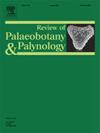澳大利亚安格尔西琥珀中保存的始新世苔类和苔藓
IF 1.7
3区 地球科学
Q2 PALEONTOLOGY
引用次数: 0
摘要
本文报道了澳大利亚维多利亚Anglesea琥珀中发现的5块苔藓植物化石,它们的年代可追溯到中始新世晚期(42Ma),从而加强了古树树脂沉积的意义。其中两个标本所保存的特殊细节为其新种Radula panduriformis sp. nov.和新属Hyponychium pentadactylum gen. et sp. nov.的描述提供了充分的依据。Hyponychium的深层解剖的五裂片下叶不同于现存和灭绝的分类群,由于缺乏孢子体特征,该化石的亲缘性不确定。本文描述的其他化石保留了重要的细节,但缺乏孢子体特征限制了它们的分类到属或更高的水平,突出了精确识别化石苔藓植物关系的困难。所有展示的化石都是南半球有记录的最早的化石,支持了始新世中期维多利亚温暖潮湿森林存在的既定知识。本文章由计算机程序翻译,如有差异,请以英文原文为准。
Eocene liverwort and moss species preserved in Anglesea amber from Australia
Five bryophyte fossils recovered in amber at Anglesea, Victoria (Australia) are presented, dating from the late middle Eocene (42Ma), reinforcing the significance of ancient tree resin deposits. Exceptional detail preserved in two of these specimens provide adequate basis for their description as new species, Radula panduriformis sp. nov., and the new genus Hyponychium pentadactylum gen. et sp. nov. The deeply dissected five-lobed underleaves of Hyponychium differ from extant and extinct taxa, and in the absence of sporophytic characters, the affinity of this fossil is uncertain. Other fossils described herein retain significant detail, but the absence of sporophytic characteristics limits their classification to the genus level or higher, highlighting the difficulty of precisely identifying fossil bryophyte relationships. All fossils presented are the earliest recorded examples of their families from the Southern Hemisphere and supports established knowledge of the presence of warm and humid forests in middle Eocene Victoria.
求助全文
通过发布文献求助,成功后即可免费获取论文全文。
去求助
来源期刊
CiteScore
3.50
自引率
21.10%
发文量
149
审稿时长
6 months
期刊介绍:
The Review of Palaeobotany and Palynology is an international journal for articles in all fields of palaeobotany and palynology dealing with all groups, ranging from marine palynomorphs to higher land plants. Original contributions and comprehensive review papers should appeal to an international audience. Typical topics include but are not restricted to systematics, evolution, palaeobiology, palaeoecology, biostratigraphy, biochronology, palaeoclimatology, paleogeography, taphonomy, palaeoenvironmental reconstructions, vegetation history, and practical applications of palaeobotany and palynology, e.g. in coal and petroleum geology and archaeology. The journal especially encourages the publication of articles in which palaeobotany and palynology are applied for solving fundamental geological and biological problems as well as innovative and interdisciplinary approaches.

 求助内容:
求助内容: 应助结果提醒方式:
应助结果提醒方式:


